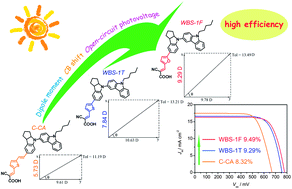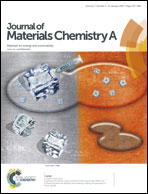Influence of conjugated π-linker in D–D–π–A indoline dyes: towards long-term stable and efficient dye-sensitized solar cells with high photovoltage
Abstract
The judicious choice of conjugated π-linkers is a critical strategy towards the energy-level engineering of donor–π–acceptor (D–π–A) sensitizers. Given that the vinyl bond on π-bridge thiophene segment can deteriorate its intrinsic photo-stability, we systematically study three D–D–π–A indoline dyes C-CA, WBS-1T and WBS-1F with different conjugated π-linkers (vinylthiophene, thiophene and furan) for high efficiency, long-term stable dye-sensitized solar cells (DSSCs). Compared with the vinylthiophene unit in C-CA, the conjugated π-linker of the thiophene or furan group in WBS-1T and WBS-1F can improve the solar cell performance with a great enhancement in the open-circuit photovoltage (VOC). As an overall result of the upshift of the TiO2 conduction band (CB) edge and the slow charge recombination, the VOC values are in the order WBS-1F (779 mV) > WBS-1T (756 mV) > C-CA (670 mV). Moreover, the CB edge shift of TiO2 is the major contribution to the large difference in VOC, accounting for 80% of the enhancement. Both the stepped light-induced transient measurements (SLIT) and the molecular dipole simulation are accounted for well by the observed superior photovoltage upon removal of the vinyl group in the conjugated π-linker. The higher molecular dipole moments can bring forth a more effective charge separation between donor and acceptor units, resulting in a remarkable increase in VOC. Using a liquid electrolyte, WBS-1F shows an impressively high efficiency of 9.49% with a high photovoltage of 779 mV. Its efficiency reaches 8.03% with ionic-liquid electrolyte while it reduces to 7.60% after a 1000 h aging test. Our work has shown that for D–π–A organic dyes, the vinyl unit in the conjugated π-linker is detrimental to the molecular dipole moment, the upshift of TiO2 CB edge, and the suppression of charge recombination, as well as the photo-stability.


 Please wait while we load your content...
Please wait while we load your content...